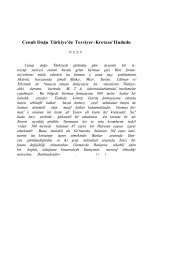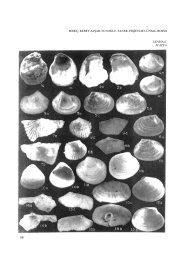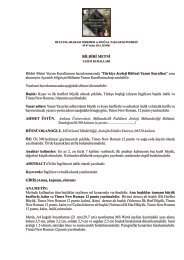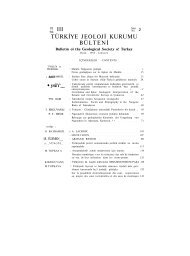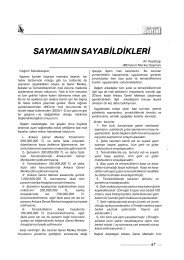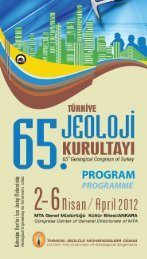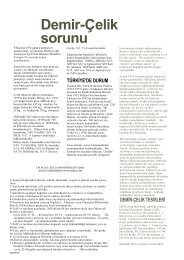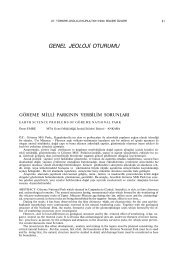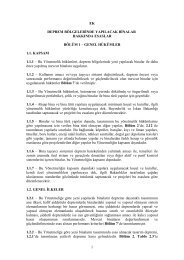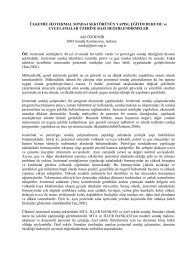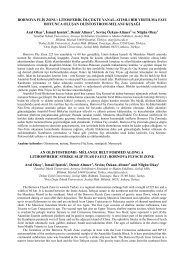Paleosismoloji ve Arkeosismoloji Palaeoseismology and ...
Paleosismoloji ve Arkeosismoloji Palaeoseismology and ...
Paleosismoloji ve Arkeosismoloji Palaeoseismology and ...
You also want an ePaper? Increase the reach of your titles
YUMPU automatically turns print PDFs into web optimized ePapers that Google loves.
62 nd Geological Kurultai of Turkey, 13−17 April 2009, MTA–Ankara, Türkiye<br />
(Semi)Quantitati<strong>ve</strong> Assessment of Seismically Induced Damage<br />
at the Archaeological Site of Pinara (SW Turkey)<br />
Barış Yerli 1 , Johan ten Veen 2 , Manuel Sintubin 3 , Volkan Karabacak 4 ,<br />
C. Çağlar Yalçıner 4 & Erhan Altunel 4<br />
1 Institute for Geology, Mineralogy <strong>and</strong> Geophysics, Ruhr Uni<strong>ve</strong>rsity, Uni<strong>ve</strong>rsitätsstrasse 150,<br />
D-44801, Bochum, Germany (E-mail: baris.yerli@ruhr-uni-bochum.de )<br />
2 TNO Built Environment <strong>and</strong> Geosciences, P.O. Box 80015, 3508 TA, Netherl<strong>and</strong>s<br />
3 Geodynamics & Geofluids Research Group, K.U. Leu<strong>ve</strong>n, Celestijnenlaan 200E,<br />
3001 Leu<strong>ve</strong>n, Belgium<br />
4<br />
Eskişehir Osmangazi Uni<strong>ve</strong>rsity, Engineering Faculty, Department of Geological Engineering,<br />
Meşelik, TR−26040 Eskişehir, Turkey<br />
Seismically induced damage at the archaeological sites gi<strong>ve</strong>s <strong>ve</strong>ry important clues to increase our<br />
knowledge on historical earthquakes. The (semi)quantitati<strong>ve</strong> methods (e.g. directional measurements,<br />
digital scanning techniques) provide reliable data to distinguish seismic related damage from<br />
anthropogenic <strong>and</strong> other natural damages. These methods make also possible the numerical<br />
assessment of earthquake-related damage on archaeological structures. Archaeological research will<br />
benefit from a more frequent application of the discussed methods by gaining more significant <strong>and</strong><br />
reliable results.<br />
The semi-quantitati<strong>ve</strong> methods ha<strong>ve</strong> been applied in Lycian ancient city of Pinara to get reliable data<br />
for the assessment of seismically induced damage. The ancient city of Pinara (500 BC – 900 AD) is<br />
located in the western margin fault zone of Eşen basin (SW Turkey). Archaeological <strong>and</strong> historical<br />
data suggest that the city has been struck by at least three major earthquakes (141, 240, <strong>and</strong> 1851 AD).<br />
To date, little is known about the physical parameters of these earthquakes (e.g. epicenter, magnitude,<br />
causati<strong>ve</strong> fault). To use a methodological approach which provides reliable evaluation of<br />
archaeoseismological site potential is needed for a dependable archaeoseismological work. The logictree<br />
methodology for archaeoseismology applied to Pinara. The evaluation of site potential factor for<br />
Pinara indicates that the palaeoearthquakes may ha<strong>ve</strong> been recorded in the archaeological relicts.<br />
The observations <strong>and</strong> measurements from fallen columns, tensile cracks, tilted or collapsed walls <strong>and</strong><br />
disoriented structures in Pinara indicates that the damage are seismic related. These measurements<br />
re<strong>ve</strong>al also a systematic of directions. The measured fall direction of columns show ESE−WNW <strong>and</strong><br />
NNW−SSE directions <strong>and</strong> the measurements of opened joint directions indicate also ESE−WNW<br />
directions which are about perpendicular or parallel to the basin margin fault close to the Pinara.<br />
Ground-based LIDAR (Light Detection <strong>and</strong> Ranging) is a promising, rather new, scanning technology<br />
that determines spatial position of an object or surface <strong>and</strong> provides high-resolution 3-D digital data.<br />
This technique has been used to map the damage <strong>and</strong> o<strong>ve</strong>rall attitude of a Roman Theatre in the<br />
ancient Lycian city of Pinara. The measured seating rows of the theatre show a systematic NWtrending<br />
tilt ranging between 0.65° <strong>and</strong> 0.95°, a resolution that could not be attained by previous<br />
manual compass readings because errors invol<strong>ve</strong>d with compass are usually >2°. This tilt appears<br />
perpendicular to the NE-trending basin margin fault, suggesting that fault-block rotation may ha<strong>ve</strong><br />
been responsible for the tilt of Pleistocene terrace <strong>and</strong> the theatre which is build on. The estimated<br />
total normal-fault displacement on basin margin fault with the tilt of roman theatre is about 4 m since<br />
roman period. This displacement value, characteristics of fault <strong>and</strong> the damage pattern at Pinara which<br />
is indicating a maximum intensity of VIII-IX (MSK), earthquake magnitude for each e<strong>ve</strong>nt would not<br />
ha<strong>ve</strong> exceeded Mw ~6.5. To sum up, the evidence suggests that se<strong>ve</strong>ral earthquakes are responsible<br />
for the damages <strong>and</strong> total tilt of the theatre in Pinara ancient city.<br />
Key Words: archaeoseismology, earthquake damage, quantitati<strong>ve</strong> assessment, acti<strong>ve</strong> normal fault,<br />
lidar, southwest Turkey<br />
1013



